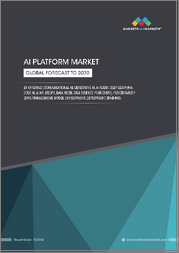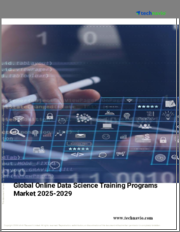
|
시장보고서
상품코드
1609807
일본의 데이터 사이언스 플랫폼 시장 보고서 : 컴포넌트, 용도, 업계, 지역별(2025-2033년)Japan Data Science Platform Market Report by Component, Application, Vertical, and Region 2025-2033 |
||||||
일본의 데이터 사이언스 플랫폼 시장의 시장 규모는 2024년에 43억 달러에 달했습니다. 향후 IMARC Group은 이 시장이 2033년까지 142억 달러에 달하며, 2025-2033년 14.2%의 성장률(CAGR)을 보일 것으로 예측하고 있습니다. 헬스케어 분야에서 데이터 사이언스 플랫폼의 채택 증가, 다양한 비즈니스에서 클라우드 기반 솔루션에 대한 요구의 증가, 데이터 사이언스 플랫폼에 대한 첨단 기술의 주입 증가는 시장 성장을 촉진하는 주요 요인의 하나입니다.
본 리포트에서 답변하는 주요 질문
- 일본의 데이터 사이언스 플랫폼 시장은 지금까지 어떻게 추이해 왔으며, 향후 어떻게 추이하는가?
- COVID-19가 일본의 데이터 사이언스 플랫폼 시장에 미친 영향은?
- 일본의 데이터 사이언스 플랫폼 시장의 컴포넌트별 내역은?
- 일본의 데이터 사이언스 플랫폼 시장의 용도별 내역은?
- 일본의 데이터 사이언스 플랫폼 시장의 업계별 내역은?
- 일본의 데이터 사이언스 플랫폼 시장의 밸류체인에는 어떤 단계가 있는가?
- 일본의 데이터 사이언스 플랫폼에서 주요 촉진요인과 과제는 무엇인가?
- 일본의 데이터 사이언스 플랫폼 시장의 구조와 주요 기업은?
- 일본의 데이터 사이언스 플랫폼 시장에서 경쟁의 정도는?
목차
제1장 서문
제2장 조사 범위와 조사 방법
- 조사의 목적
- 이해관계자
- 데이터 소스
- 시장 추정
- 조사 방법
제3장 개요
제4장 일본의 데이터 사이언스 플랫폼 시장 : 서론
- 개요
- 시장 역학
- 업계 동향
- 경쟁 정보
제5장 일본의 데이터 사이언스 플랫폼 시장 구도
- 과거 및 현재 시장 동향(2019-2024년)
- 시장 예측(2025-2033)
제6장 일본의 데이터 사이언스 플랫폼 시장 : 컴포넌트별 내역
- 소프트웨어
- 서비스
제7장 일본의 데이터 사이언스 플랫폼 시장 : 용도별 내역
- 마케팅과 세일즈
- 물류
- 재무와 회계
- 고객 지원
- 기타
제8장 일본의 데이터 사이언스 플랫폼 시장 : 업계별 내역
- IT·통신
- 헬스케어
- BFSI
- 제조
- 소매업과 E-Commerce
- 기타
제9장 일본의 데이터 사이언스 플랫폼 시장 : 경쟁 구도
- 개요
- 시장 구조
- 시장 기업 포지셔닝
- 주요 성공 전략
- 경쟁 대시보드
- 기업 평가 상한
제10장 주요 기업의 개요
제11장 일본의 데이터 사이언스 플랫폼 시장 : 업계 분석
- 촉진요인·억제요인·기회
- Porter's Five Forces 분석
- 밸류체인 분석
제12장 부록
KSA 24.12.24Japan data science platform market size reached USD 4.3 Billion in 2024. Looking forward, IMARC Group expects the market to reach USD 14.2 Billion by 2033, exhibiting a growth rate (CAGR) of 14.2% during 2025-2033. Increased adoption of data science platforms within the healthcare sector, the escalating need for cloud-based solutions across diverse businesses, and the growing infusion of advanced technologies into data science platforms are among the primary factors propelling market growth.
A data science platform comprises an extensive infrastructure encompassing software and hardware components, offering the essential tools, technologies, and resources to facilitate various stages of the data science workflow. Data science is a multifaceted discipline that encompasses tasks such as data collection, data cleansing, data analysis, and data interpretation, all aimed at extracting valuable insights and supporting data-driven decision-making. These platforms provide an array of capabilities, including tools for data extraction, transformation, and loading (ETL), along with connectors enabling access to diverse data sources such as databases, data warehouses, APIs, and more. Moreover, they furnish a wide spectrum of machine learning algorithms and modeling tools for constructing predictive and descriptive models.
Japan Data Science Platform Market Trends:
Presently, the growth of the data science platform market in Japan is primarily steered by the escalating adoption within the healthcare sector, where these platforms efficiently manage, analyze, and integrate substantial volumes of both structured and unstructured data. Additionally, there is an increasing preference for cloud-based solutions across diverse global business entities, contributing to a favorable market environment. Furthermore, there is a rising demand for cost-effective and efficient decision-making tools on a wide scale. This growing demand, combined with the expanding use of data science platforms that enhance enterprise analysis and productivity, is driving market expansion. Moreover, the incorporation of artificial intelligence (AI), the Internet of Things (IoT), and machine learning (ML) into data science platforms is creating promising growth prospects for industry participants. Besides this, the increasing need for data science platforms, which offer a unified and integrated approach to constructing, managing, and optimizing predictive models for businesses, is positively impacting the market. Furthermore, the surging demand for data science platforms due to the evolution of big data technologies is contributing to market growth. Moreover, the heightened requirement for data science platforms within the BFSI sector, driven by the increased use of banking services, is expected to reinforce market expansion in Japan over the forecasted period.
Japan Data Science Platform Market Segmentation:
Component Insights:
- Software
- Services
Application Insights:
- Marketing and Sales
- Logistics
- Finance and Accounting
- Customer Support
- Others
Vertical Insights:
- IT and Telecommunication
- Healthcare
- BFSI
- Manufacturing
- Retail and E-Commerce
- Others
Competitive Landscape:
The market research report has also provided a comprehensive analysis of the competitive landscape. Competitive analysis such as market structure, key player positioning, top winning strategies, competitive dashboard, and company evaluation quadrant has been covered in the report. Also, detailed profiles of all major companies have been provided.
Key Questions Answered in This Report:
- How has the Japan data science platform market performed so far and how will it perform in the coming years?
- What has been the impact of COVID-19 on the Japan data science platform market?
- What is the breakup of the Japan data science platform market on the basis of component?
- What is the breakup of the Japan data science platform market on the basis of application?
- What is the breakup of the Japan data science platform market on the basis of vertical?
- What are the various stages in the value chain of the Japan data science platform market?
- What are the key driving factors and challenges in the Japan data science platform?
- What is the structure of the Japan data science platform market and who are the key players?
- What is the degree of competition in the Japan data science platform market?
Table of Contents
1 Preface
2 Scope and Methodology
- 2.1 Objectives of the Study
- 2.2 Stakeholders
- 2.3 Data Sources
- 2.3.1 Primary Sources
- 2.3.2 Secondary Sources
- 2.4 Market Estimation
- 2.4.1 Bottom-Up Approach
- 2.4.2 Top-Down Approach
- 2.5 Forecasting Methodology
3 Executive Summary
4 Japan Data Science Platform Market - Introduction
- 4.1 Overview
- 4.2 Market Dynamics
- 4.3 Industry Trends
- 4.4 Competitive Intelligence
5 Japan Data Science Platform Market Landscape
- 5.1 Historical and Current Market Trends (2019-2024)
- 5.2 Market Forecast (2025-2033)
6 Japan Data Science Platform Market - Breakup by Component
- 6.1 Software
- 6.1.1 Overview
- 6.1.2 Historical and Current Market Trends (2019-2024)
- 6.1.3 Market Forecast (2025-2033)
- 6.2 Services
- 6.2.1 Overview
- 6.2.2 Historical and Current Market Trends (2019-2024)
- 6.2.3 Market Forecast (2025-2033)
7 Japan Data Science Platform Market - Breakup by Application
- 7.1 Marketing and Sales
- 7.1.1 Overview
- 7.1.2 Historical and Current Market Trends (2019-2024)
- 7.1.3 Market Forecast (2025-2033)
- 7.2 Logistics
- 7.2.1 Overview
- 7.2.2 Historical and Current Market Trends (2019-2024)
- 7.2.3 Market Forecast (2025-2033)
- 7.3 Finance and Accounting
- 7.3.1 Overview
- 7.3.2 Historical and Current Market Trends (2019-2024)
- 7.3.3 Market Forecast (2025-2033)
- 7.4 Customer Support
- 7.4.1 Overview
- 7.4.2 Historical and Current Market Trends (2019-2024)
- 7.4.3 Market Forecast (2025-2033)
- 7.5 Others
- 7.5.1 Historical and Current Market Trends (2019-2024)
- 7.5.2 Market Forecast (2025-2033)
8 Japan Data Science Platform Market - Breakup by Vertical
- 8.1 IT and Telecommunication
- 8.1.1 Overview
- 8.1.2 Historical and Current Market Trends (2019-2024)
- 8.1.3 Market Forecast (2025-2033)
- 8.2 Healthcare
- 8.2.1 Overview
- 8.2.2 Historical and Current Market Trends (2019-2024)
- 8.2.3 Market Forecast (2025-2033)
- 8.3 BFSI
- 8.3.1 Overview
- 8.3.2 Historical and Current Market Trends (2019-2024)
- 8.3.3 Market Forecast (2025-2033)
- 8.4 Manufacturing
- 8.4.1 Overview
- 8.4.2 Historical and Current Market Trends (2019-2024)
- 8.4.3 Market Forecast (2025-2033)
- 8.5 Retail and E-Commerce
- 8.5.1 Overview
- 8.5.2 Historical and Current Market Trends (2019-2024)
- 8.5.3 Market Forecast (2025-2033)
- 8.6 Others
- 8.6.1 Historical and Current Market Trends (2019-2024)
- 8.6.2 Market Forecast (2025-2033)
9 Japan Data Science Platform Market - Competitive Landscape
- 9.1 Overview
- 9.2 Market Structure
- 9.3 Market Player Positioning
- 9.4 Top Winning Strategies
- 9.5 Competitive Dashboard
- 9.6 Company Evaluation Quadrant
10 Profiles of Key Players
- 10.1 Company A
- 10.1.1 Business Overview
- 10.1.2 Product Portfolio
- 10.1.3 Business Strategies
- 10.1.4 SWOT Analysis
- 10.1.5 Major News and Events
- 10.2 Company B
- 10.2.1 Business Overview
- 10.2.2 Product Portfolio
- 10.2.3 Business Strategies
- 10.2.4 SWOT Analysis
- 10.2.5 Major News and Events
- 10.3 Company C
- 10.3.1 Business Overview
- 10.3.2 Product Portfolio
- 10.3.3 Business Strategies
- 10.3.4 SWOT Analysis
- 10.3.5 Major News and Events
- 10.4 Company D
- 10.4.1 Business Overview
- 10.4.2 Product Portfolio
- 10.4.3 Business Strategies
- 10.4.4 SWOT Analysis
- 10.4.5 Major News and Events
- 10.5 Company E
- 10.5.1 Business Overview
- 10.5.2 Product Portfolio
- 10.5.3 Business Strategies
- 10.5.4 SWOT Analysis
- 10.5.5 Major News and Events
11 Japan Data Science Platform Market - Industry Analysis
- 11.1 Drivers, Restraints, and Opportunities
- 11.1.1 Overview
- 11.1.2 Drivers
- 11.1.3 Restraints
- 11.1.4 Opportunities
- 11.2 Porters Five Forces Analysis
- 11.2.1 Overview
- 11.2.2 Bargaining Power of Buyers
- 11.2.3 Bargaining Power of Suppliers
- 11.2.4 Degree of Competition
- 11.2.5 Threat of New Entrants
- 11.2.6 Threat of Substitutes
- 11.3 Value Chain Analysis



















